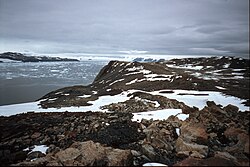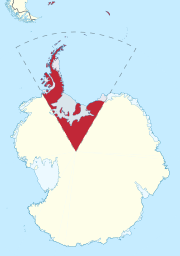British Antarctic Territory
| British Antarctic Territory (British overseas territory) | |
 Jade Point, Graham Land | |
|---|---|

| |

| |
| Research and discovery | |
| Area: | 660,000 square miles |
| Population: | 250 est. |
| Capital: | Rothera (Main base) |
| TLD: | .aq |
The British Antarctic Territory is the sector of Antarctica claimed by the United Kingdom and as such it constitutes a British overseas territory.
The British Antarctic Territory comprises the region south of 60°S latitude and between longitudes 20°W and 80°W, forming a wedge shape which extends to the South Pole. The Territory includes:
- Islands:
- Of the Antarctic continent:
- The Antarctic Peninsula (Graham Land and Palmer Land)
- Coats Land
- Queen Elizabeth Land, which reaches to the South Pole.
There are no native inhabitants. The Territory is inhabited only by the staff of research and support stations operated and maintained by the British Antarctic Survey and other organisations, and those at stations of Argentina, Chile and other countries maintained here.
Contents
Claims and counter-claims
Britain made its claim to this portion of the Antarctic by Letters Patent of 1908 and 1917, which declared that this territory, together with South Georgia and the South Sandwich Islands, as the Falkland Islands Dependencies. The British Antarctic Territory was separated and formed as a separate colony on 3 March 1962, in consequence of the Antarctic Treaty, which effectively suspended all national claims to Antarctica.
The Treaty came into force in 1961, and Article 1 states "The treaty does not recognize, dispute, nor establish territorial sovereignty claims; no new claims shall be asserted while the treaty is in force". Most countries of the world do not recognise territorial claims in Antarctica. Britain, France, Norway, New Zealand and Australia, all of whom have territorial claims on the continent, mutually recognise each other's claims.[1][2] Argentina and Chile dispute the British claim, and make their own counter-claims that overlap both Britain's and each other's.
History
The United Kingdom has had a continuous presence in the far South Atlantic since 1833 when it reasserted sovereignty over its Falkland Islands. In 1908, Britain extended its territorial claim by declaring sovereignty over "South Georgia, the South Orkneys, the South Shetlands, and the Sandwich Islands, and Graham's Land, situated in the South Atlantic Ocean and on the Antarctic continent to the south of the 50th parallel of south latitude, and lying between the 20th and the 80th degrees of west longitude".[3] All these territories were administered as Falkland Islands Dependencies from Stanley by the Governor of the Falkland Islands.
In 1917, the wording of the claim was modified, so as to include unambiguously all the territory in the sector stretching to the South Pole (thus encompassing all of the present-day British Antarctic Territory). The new claim covered "all islands and territories whatsoever between the 20th degree of west longitude and the 50th degree of west longitude which are situated south of the 50th parallel of south latitude; and all islands and territories whatsoever between the 50th degree of west longitude and the 80th degree of west longitude which are situated south of the 58th parallel of south latitude".[3]
In 1943, at the height of Second World War, the United Kingdom undertook a military operation known as Operation Tabarin, to provide reconnaissance and meteorological information in the South Atlantic Ocean. This "secret" wartime project became the civilian Falkland Islands Dependencies Survey and later the British Antarctic Survey (BAS). BAS is responsible for most of the United Kingdom's scientific research in Antarctica.
In the 1950s the Antarctic Treaty was negotiated to demilitarise the region and retain Antarctica, defined as all land and ice shelves south of 60°S latitude, for peaceful research purposes. The treaty was entered into in 1961.
Geography
The British Antarctic Territory includes the Antarctic Peninsula, the South Shetland Islands, South Orkney Islands and numerous other offshore islands, the Ronne Ice Shelf in the Weddell Sea), parts of Coats Land, and a triangle of central continental Antarctica converging on the South Pole.
Over 99 percent of the territory's land surface is covered by a permanent ice sheet, up to 3 miles thick.[4] The highest peak is Mount Jackson, on the Antarctic Peninsula, at 10,446 feet: the highest point of any British territory.[4]
Vegetation
There are very few plants in the British Antarctic Territories and most of them are mosses and lichens, but there are also two flowering plants: the Antarctic hairgrass and Antarctic pearlwort.[5]
Wildlife
Many bird species, including seven species of penguin breed in the British Antarctic Territories. The British Antarctic Territories are also home to six species of seals.[5]
Administration
The British Antarctic Territory is administered by the Foreign and Commonwealth Office (FCO). A Commissioner is appointed and is always the Head of the FCO's Overseas Territories Department.
The Territory has a full suite of laws, and legal and postal administrations. Given the provisions of the Antarctic Treaty System, the Territory does not enforce its laws on foreign nations which maintain scientific bases within the Territory. It is self-financing, with income from the sale of postage stamps and income tax.
Nationality law
The territory is fully a part of the British Overseas Territories for nationality purposes. It is possible to hold British Overseas Territories citizenship (BOTC) by virtue of a connection with the Territory. Additionally, since the relevant provisions of the British Overseas Territories Act 2002 came into force on 21 May 2002, a BOTC connected with the territory would also hold British citizenship.
Although this territory's immigration laws would not allow for naturalisation, a person born in the territory before 1983 would hold BOTC (and British citizenship) on that basis. British citizenship and BOTC would also extend to the first generation born overseas. No people currently fall into this category. Changes to British nationality law from 1 January 1983 ensure that no claims to BOTC or British citizenship by virtue of a connection to the territory can now be made by those born from that date.
Research stations
The British Antarctic Survey has two permanently staffed research stations in the Territory:[6][7]
Signy was operated from 1947 until 1996 and now is only staffed in the summer.[8] There are also two summer-only forward operating stations, at Fossil Bluff and Sky Blu.
Faraday was maintained until 1996, when it was sold to the Ukraine and renamed Akademik Vernadsky Station.[9]
Since 1996, the historic base at Port Lockroy on Goudier Island has been staffed by the UK Antarctic Heritage Trust during the Antarctic summer. Receiving about 10,000 visitors a year, it is one of the most visited sites on the continent. Visitors can tour the museum, buy souvenirs, post mail, and view the large gentoo penguin colony.[10]
Argentine presence in the territory dates to the foundation of the Orcadas Base on the South Orkney Islands in 1903.
A number of other nations maintain bases in the territory, many in the South Shetland Islands.[4]
Postage stamps and coins
Despite the lack of permanent inhabitants, the British Antarctic Territory issues its own postage stamps. While some are actually used by visiting tourists and resident scientists, the bulk are sold overseas to collectors. The first issue came in 1963, an engraved set with 15 values ranging from ½d to one pound, featuring a portrait of Queen Elizabeth overlooking various scenes of human activity in Antarctica. Several additional issues in the 1960s were followed by a decimalisation issue in 1971 produced by overprinting the 1963 stamps.
In 2008/2009, as part of the celebrations of the centenary of the 1908 British territorial claim, the British Antarctic Territory issued its first ever legal-tender coin.[11]
Footnotes
- ↑ http://books.google.co.uk/books?id=Sg49AAAAIAAJ&pg=PA18
- ↑ http://www.worldstatesmen.org/Br_Ant_Terr.html
- ↑ 3.0 3.1 International law for Antarctica, p. 652, Francesco Francioni and Tullio Scovazzi, 1996
- ↑ 4.0 4.1 4.2 British Antarctic Territory, Country Facts, Foreign & Commonwealth Office
- ↑ 5.0 5.1 Commonwealth Secretariat Website
- ↑ "Research Stations in Antarctica". British Antarctic Survey. http://www.antarctica.ac.uk/living_and_working/research_stations/index.php. Retrieved 2008-09-07.
- ↑ http://www.ingenia.org.uk/ingenia/articles.aspx?Index=334 Extreme Engineering: the challenges of working in Antarctica, Ingenia, September 2005
- ↑ "Signy Research Station". British Antarctic Survey. http://www.antarctica.ac.uk/living_and_working/research_stations/signy/index.php. Retrieved 2008-09-07.
- ↑ "Faraday Station - History". British Antarctic Survey. http://www.antarctica.ac.uk/about_bas/our_history/stations_and_refuges/faraday.php. Retrieved 2008-09-07.
- ↑ "Port Lockroy". UK Antarctic Heritage Trust. Archived from the original on 2008-05-21. http://web.archive.org/web/20080521090205/http://www.ukaht.org/portlockroy.htm. Retrieved 2008-09-07.
- ↑ The British Antarctic Territory Currency, Antarctic Heritage Trust


